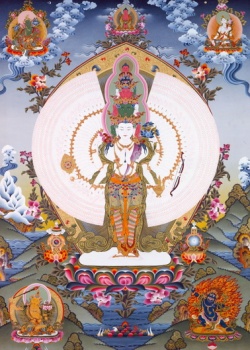Vimalakirti Nirdesa Sutra
Vimalakīrti is the central figure in the Buddhist Vimalakīrti Nirdeśa Sūtra, which presents him as the ideal Mahayanist lay practitioner and a contemporary of Gautama Buddha (6th to 5th century BCE).
Translator Burton Watson argues that the Vimalakirti Sutra was likely composed in India in approximately 100 CE.
Vimalakirti, a Sanskrit word, means undefiled and pure reputation. Vimalakirti was said to be a native of Vaisali, and an upasaka (not a monk) to assist Shakyamuni to preach and cross over the human beings. The Sutra is the record of interesting conversation between Vimalakirti and Manjusri Bodhisattva regarding the understanding of One Buddha Vehicle.
Also called Vimalakirti Nirdesa Sutra. A key Mahayana sutra particularly popular with Zen and to a lesser extent Pure Land followers. The main protagonist is a layman named Vimalakirti who is the equal of many Bodhisattvas in wisdom, eloquence, etc. He explained the teaching of Emptiness in terms of non duality ... "The true nature of things is beyond the limiting concepts imposed by words." Thus, when asked by Manjusri to define the non dual Truth, Vimalakirti simply remained silent.
see also: The Vimalakīrti Sutra; Vimalakirti Sutra
